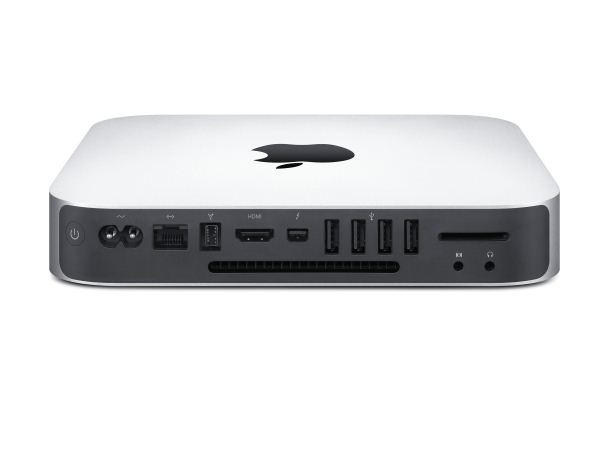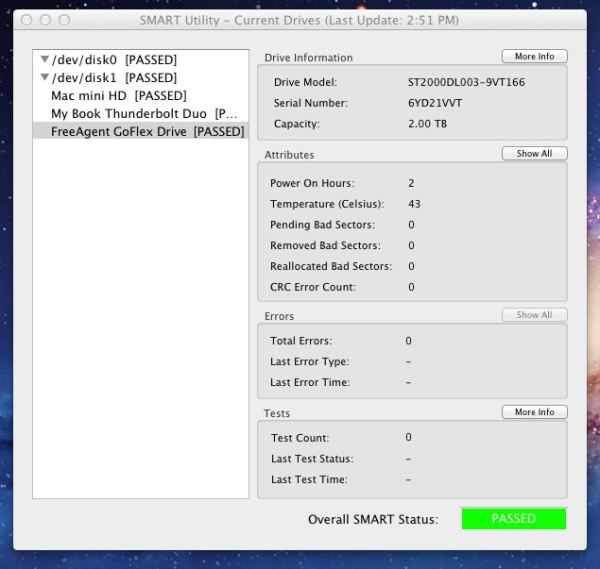A Tale Of Two Thunderbolt Storage Devices: Seagate's GoFlex Desk and Western Digital's Thunderbolt Duo
by Brian Dipert on May 13, 2012 7:52 PM EST- Posted in
- Thunderbolt
- Seagate
- WD
- Western Digital
Between the two Seagate dock adapters, in combination with the interface allotment on the Mac mini, I had three different bus options available to me on the GoFlex Desk...
so I tested 'em all:
| Seagate GoFlex Desk Benchmark Results | ||
| Interface | AJA Write (MBytes/sec) | AJA Read (MBytes/sec) |
| USB 2 | 26.5 | 34.1 |
| FireWire 800 | 51.1 | 39.6 |
| Thunderbolt | 135.7 | 136.1 |
Recall my earlier comments, "Yet as anyone who's used a USB 2.0 hard drive or flash drive knows, the bus's read and write performance still leaves a lot to be desired, especially for video and other large-file-size material." I think that the results of this study justify that particular stance. FireWire 800 delivered speedier results, but not dramatically so, and this was the only case where writes were faster than reads (for unknown reasons).
Now take a look at the Thunderbolt results, and the rationalization for the interface become clear. Had I had an available eSATA port on both the drive and the system, I likely would have gotten similar data. However, as previously mentioned, eSATA's storage-only relevance led to modest-at-best adoption, and as such it wasn't a testing option in this particular setup. Note the slightly faster transfer speeds of the GoFlex Desk than with the single-disk and mirrored test configurations of the Thunderbolt Duo, likely reflective of the faster Seagate HDD rotational speed.
Anand had previously noted high operating temperatures under load when he tested the 3 TByte GoFlex Desk, and subsequently pointed out the improved airflow characteristics of the 4 TByte product's enclosure design in last year's follow-up review. My GoFlex Desk for Mac appears to leverage the latter enclosure design, and as such its operating temperature results were acceptable, particularly for a completely silent fanless design:
As an aside, although I was unable to run AJA System Test on my Mac mini's HDD for some unknown reason, here's what I got when I benchmarked the personally-upgraded SSD in my "Mid-2010" 13" MacBook Pro (Mac OS 10.6, 2.4 GHz Intel Core 2 Duo, 8 GBytes 1067 MHz DDR3 SDRAM, Intel SSDSA2CW300G3 300 GByte SSD, TRIM Enabler activated):
| MacBook Pro Benchmark Results | ||
| Interface | AJA Write (MBytes/sec) | AJA Read (MBytes/sec) |
| 3 Gbps SATA | 171.7 | 264.8 |












46 Comments
View All Comments
name99 - Monday, May 14, 2012 - link
"Given that the PCI Express channel of the Thunderbolt interface delivers 10 Gbps of peak bandwidth in either direction, I next decided to see what would happen if I tethered the Seagate and WD drives together."You can do even better than this. You should have been able, in Disk Utility, to create a striped drive consisting of the two WD drives and the Seagate drive. This would be gated by the speed of the slowest drive, so should give you around 360MB/s read and write speeds.
Disk Utility is not perfect, and god knows I've sent Apple long lists of ways it can be improved; but it is pretty awesome for basic things like creating either striped arrays or large concatenated arrays.
bdipert - Monday, May 14, 2012 - link
Dear name99, that's a great idea. I'm traveling at the moment but will give it a shot when I get back in front of the Mac mini. I agree with you that it conceptually should work, and will be performance-gated by the drives in the Thunderbolt Duo.Torrijos - Monday, May 14, 2012 - link
You talked a bit about the impact of running a soft-RAID device being negligible, it would be nice to know the impact on the OS when pushing those mass storage devices to the limit.I've bought an USB3 extension card for my mac and while transfer speed are great, OS responsiveness takes a hit every time a big transfer occurs (TM backups are a pain).
A formal test of the impact of USB 3, ThunderBolt would be nice.
repoman27 - Monday, May 14, 2012 - link
Have you watched Activity Monitor during a TM backup to see what's being stressed? I usually associate the performance drop during TM backups with the crazy amount of small random reads that need to be performed on the system volume while you're still trying to use it.Draconian - Monday, May 14, 2012 - link
So basically, if you're really concerned about performance, an SSD using an old 3 Gbps connection will read and write twice as fast as a HDD using a Thunderbolt connection?I would be interested in knowing what the results would be with a HDD using an eSATA connection. And of course USB 3.0.
jabber - Monday, May 14, 2012 - link
......companies selling 7N Thunderbolt cables that cost them $3 to make but selling them to audiophiles for $3000 a go.Glindon - Monday, May 14, 2012 - link
Each connector of the thunderbolt cable has a small chip, which is why the cable costs so much. It's not just a $50 cable. iFixit has done a tear down of the cable if you want to check it out.repoman27 - Monday, May 14, 2012 - link
There are quite a few factors which make Thunderbolt cables expensive, being an active design is just one of them. If you ignore the bit about Thunderbolt being intended for iOS devices, the following blog post reveals quite a few details:http://www.patentlyapple.com/patently-apple/2012/0...
I think the snake oil salesmen that prey on the audiophiles will avoid Thunderbolt for some time, specifically because it is an expensive to manufacture, high bandwidth cable that can't be made for $3. A 2.0 m copper pipe that can carry 20 Gbps, full-duplex, plus bus power and out-of-band signaling just doesn't exist yet in the sub $20 realm.
quiksilvr - Monday, May 14, 2012 - link
You pay an arm and a fucking leg for these things and they don't even have the god damn decency to give you the wire?CalaverasGrande - Monday, May 14, 2012 - link
Just like on the MAc centric forums, people can not look past their narrow usage scenario to accommodate other perspectives.I work at a TV station, but have a background in audio production. In most prosumer studios, and quite a few mid level studios, firewire is the connection of choice for audio interface (soundcard). The high end audio interfaces have until recently all been either a PCIe card or Firewire. Add to the pile firewire based DSP such as the UAD-2 and firewire disk arrays used to insure fault tolerant and fast nearline storage.
In video production we really don't use 1394 anymore. But there are still some old boxes in use that have the mini connector. Often they get pressed into use as a transcoder or layback machine for formats we dont use natively anymore. We are all on Sony XDcam disk, which I would love to see as a consumer format!
I personally can't wait to see wider adoption of thunderbolt. I plan on upgrading to a T-bolt equipped mac after the next refresh of the MBP line.